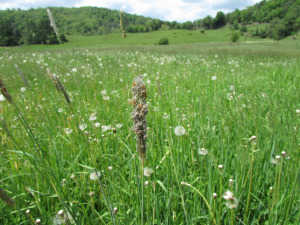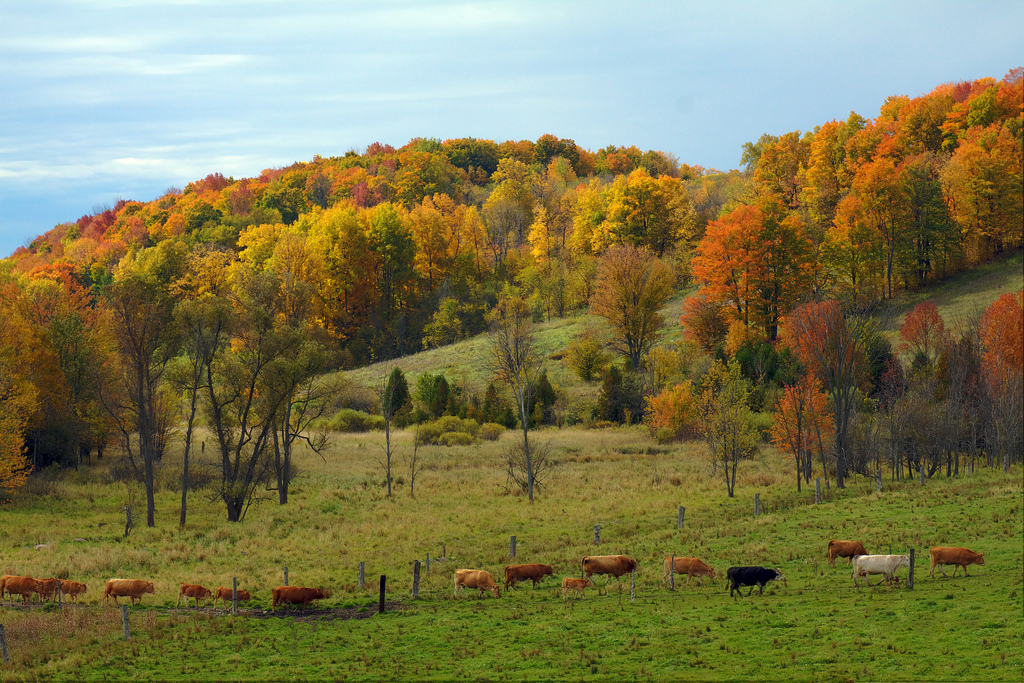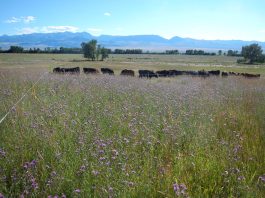 A species of grass has been increasing its presence in some hayfields and pastures. From a distance the seed head of this grass looks like that of timothy, but farmers know it cannot be because the seed heads of this grass emerge several weeks before most other grasses, while timothy is typically the last grass species to produce seed heads. This grass is called meadow foxtail (Alopecurus pratensis L.) and has been spreading in Vermont for more than a generation – probably much longer than that. This species is native to Eurasia and has adapted to regions within most of the states and provinces of the U.S. and Canada.
A species of grass has been increasing its presence in some hayfields and pastures. From a distance the seed head of this grass looks like that of timothy, but farmers know it cannot be because the seed heads of this grass emerge several weeks before most other grasses, while timothy is typically the last grass species to produce seed heads. This grass is called meadow foxtail (Alopecurus pratensis L.) and has been spreading in Vermont for more than a generation – probably much longer than that. This species is native to Eurasia and has adapted to regions within most of the states and provinces of the U.S. and Canada.
Meadow foxtail is a long-lived perennial grass that thrives in moist and/or fine-textured soils and is intolerant of drought. Early seed production, vigorous seedlings, rhizomes, and rooting from lower nodes allow this plant to form a sod and it can quickly dominate pastures and hay fields under certain conditions. [Click here to see the USDA Plant description; other detailed plant descriptions can be found under Resources Used, below.]
While meadow foxtail is quite responsive to nitrogen inputs, its yield potential is lower than most forage grasses used in dairy systems. As a pasture species, characteristic early maturity causes reduced palatability early in the grazing season. In the Northeast, once the coarse stems of the first growth are removed, the vegetative regrowth is palatable to livestock throughout the grazing season. In drier climates, the palatability is said to decline during the grazing season.
The viability of seeds in the soil seed bank is not known but is thought to be relatively short. While meadow foxtail seed can be purchased, there are no improved cultivars available in the U.S. and most commercially seed available here is probably from feral populations in the state of Oregon.
Concerns about yield and forage quality

It is intuitive that early seed head production translates to ‘stemminess’ and ‘low forage quality’ in the minds of dairy farmers and dairy nutritionists. While that association is legitimate and of serious concern, some dairy farmers have decided that they have no choice but to live with meadow foxtail. In their estimation, the cost of taking land out of production for a year to eradicate the meadow foxtail and then reseeding would take a very long time to recover.
Interestingly, farmer testimony suggests that the forage quality from fields infested with meadow foxtail is not as bad as they expected is corroborated by research done in Alberta in 1987 – 1989. This research project investigated total dry-matter yield, leaf to stem ratios, crude protein levels, ADF/NDF levels, and digestible organic matter levels of meadow foxtail compared to other forage grasses. Comments about the study are here limited to contrasting the yield and qualities of meadow foxtail and orchardgrass only. The data from the second year of the research (1989) was probably more relevant than that from 1987 because the grasses were harvested in 1989 had at forage quality levels dairy farmers often target, while the 1987 crop did not.
How did the yield of meadow foxtail compare with orchardgrass? In this case, the three-cut forage dry matter yield of the meadow foxtail was 22% lower than orchardgrass. This is a serious problem, but it is important to keep in mind that many of our perennial hayfields and pastures in the Northeast are composed largely of Kentucky bluegrass and other grasses which also have a considerably lower yield potential than orchardgrass under normal management. It is worth noting that modern orchardgrass cultivars are probably much higher-yielding than the variety used in 1989 while the yield and quality characteristics of meadow foxtail probably have not improved since then.
Just how stemmy is meadow foxtail compared to orchardgrass?
 VERY STEMMY. To describe the relative stemminess of the grasses the researchers basically separated the leaves and stems then dried and weighed them to establish leaf/stem ratio for each cutting. In 1989 for each ton of orchardgrass leaves, there were 0.59 tons of stems; and for each ton of meadow foxtail leaves, there were 1.72 tons of stems! Because dairy farmers and nutritionists typically equate stemminess with high fiber levels, these ratios may lead us to believe that the meadow foxtail has extremely poor forage quality.
VERY STEMMY. To describe the relative stemminess of the grasses the researchers basically separated the leaves and stems then dried and weighed them to establish leaf/stem ratio for each cutting. In 1989 for each ton of orchardgrass leaves, there were 0.59 tons of stems; and for each ton of meadow foxtail leaves, there were 1.72 tons of stems! Because dairy farmers and nutritionists typically equate stemminess with high fiber levels, these ratios may lead us to believe that the meadow foxtail has extremely poor forage quality.
So what about the protein and fiber levels? Considering the relative stemminess of the meadow foxtail, the results of this part of the study were counterintuitive. To begin, the protein levels of analogous plant parts (stem vs leaf) was the same or higherfor meadow foxtail as it was for orchardgrass. On a whole-plant basis, meadow foxtail had higher protein levels for cuts 1 and 2, but the average for the year was not significantly different. Neutral detergent fiber (NDF) levels were not different for any cuttings, while acid detergent fiber (ADF) levels differed only for the first cutting, with orchardgrass and meadow foxtail at 18% and 21% ADF, respectively. In vitro digestible organic matter (IVDOM) averaged 3% higher for orchardgrass. To summarize, meadow foxtail is not as nasty a feed as you might think by looking at it. The data from 1989 suggests that the biggest downsides meadow foxtail had compared to orchardgrass were a 22% lower yield and slightly higher ADF levels in the first cutting.
Management implications
Once meadow foxtail is in your fields, it will be difficult to eradicate completely. The seeds move with harvest machinery, animals, and to a lesser degree, wind and water. In fields with a significant amount of meadow foxtail, taking the first cutting early will reduce the spread of viable meadow foxtail seeds and result in better forage quality. Depending on the other species of grasses you have in your field, a wick-application of glyphosate might be an option to vastly reducing the amount of meadow foxtail in your fields, although some collateral damage is impossible to avoid.
Should you want meadow foxtail in your fields? No, but you need to run the numbers carefully to see if it is worth trying to eradicate it from your field if it is there already. If your fields are in a conventional (i.e., not organic) rotation, then the next rotation to corn has the potential to all but eradicate it from the field for a time. Staying in corn for two years with a cover crop in between would be even more effective. If you have some hay fields that are not in rotation with an annual crop, you should account for the annual yield losses and lower feed quality associated with this crop when making reseeding decisions.
For a list of the resources used to write this piece, visit Dan Hudson’s blog.





